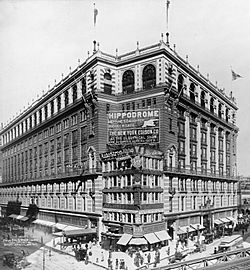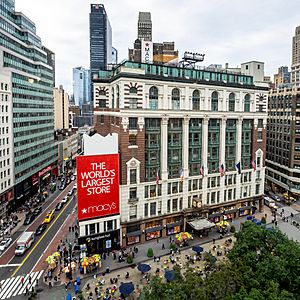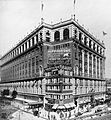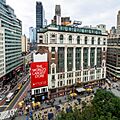Macy's Herald Square facts for kids
|
R. H. Macy and Company Store
|
|

(1907)
|
|
| Location | 151 West 34th Street Manhattan, New York |
|---|---|
| Built | 1901 |
| Architect | De Lemos & Cordes |
| NRHP reference No. | 78001873 |
Quick facts for kids Significant dates |
|
| Added to NRHP | June 2, 1978 |
| Designated NHL | June 2, 1978 |
Macy's Herald Square is the main store of the famous Macy's department store chain. You can find it in Herald Square in Manhattan, New York City. It's a huge building, one of the biggest department stores in the world! It has about 2.5 million square feet (232,257 square meters) of space. About half of that is for shopping!
The store opened in this building in 1902. Before that, Macy's had other locations in New York City. In 1978, the building became a National Historic Landmark. This means it is a very important historical place in the United States.
History of Macy's Stores
Early Stores and Founding
Macy's was started by a man named Rowland Hussey Macy. Between 1843 and 1855, he opened four different stores. His first Macy's store was in Haverhill, Massachusetts, in 1851. These early stores did not do well, but Rowland Macy learned a lot from his experiences.
In 1858, he moved to New York City. He opened a new store called "R.H Macy Dry Goods" on Sixth Avenue at 14th Street. On its first day, October 28, 1858, the store made $11.08. This would be worth about $400 today.
From the very beginning, Macy's has used a star in its logo. This star is a nod to a red star tattoo Rowland Macy got as a teenager. He got it while working on a whaling ship.
As the business grew, Macy's added more buildings nearby. They also used fun ways to get customers. These included having a store Santa Claus, special exhibits, and bright window displays. Later, the store moved to 18th Street and Broadway. This area was known as "Ladies' Mile" and was a popular shopping spot. Macy's stayed there for almost 40 years.
In 1875, Rowland Macy took on two partners: his nephew Robert M. Valentine and his cousin's husband Abiel T. La Forge. Rowland Macy passed away in 1877. His partners also died soon after. The Macy family owned the company until 1895. Then, two brothers, Isidor Straus and Nathan Straus, bought the company. They had already been selling china inside Macy's.
Moving to Herald Square
In 1902, the main Macy's store moved to Herald Square. This new location was at 34th Street and Broadway. It was quite far north from other big stores at the time. To help customers, Macy's even offered a special wagon to take them from 14th Street to 34th Street!
The Herald Square store started as one building. But it quickly grew by adding new parts. Eventually, it took up almost the entire city block. This block is bordered by Seventh Avenue, Broadway, 34th Street, and 35th Street.
There was one small building on the corner of 34th Street and Broadway that Macy's couldn't buy. It was bought by someone who wanted to stop Macy's from becoming the world's largest store. But Macy's just built around it! Today, that small building has Macy's "shopping bag" sign on it. This building became known as Million Dollar Corner because it was sold for a record $1 million in 1911.
The first Broadway store was designed in 1901-1902 by architects De Lemos & Cordes. It has a classic Palladian look. More parts were added to the west in 1924 and 1928. The Seventh Avenue building was finished in 1931. These newer parts were designed in the Art Deco style. The store still has some old wooden escalators that are still working today!
Modern Renovations
In 2012, Macy's started a big renovation of its main store. It cost about $400 million. The work finished in 2015, but Macy's keeps making changes. They want to keep the store modern and appealing to shoppers.
In recent years, Macy's has thought about adding new towers to the building. These towers could be for hotels or offices. They also considered turning the roof into a park. In 2019, Macy's shared plans for a large office building on top of the store. The updated plans in 2020 showed a tower over 900 feet (274 meters) tall. This new tower would also include improvements to the area around the store.
Exciting Events at Macy's
Macy's is famous for its amazing holiday and Christmas window displays. Every year, the Herald Square store has six special windows on the Broadway side. Each window tells a different story with animated displays and detailed scenes. Thousands of people come to see them!
In 2007, Macy's had a special art show called Art Under Glass. They used their windows to show art from different fashion designers.
Other fun events at Macy's Herald Square include:
- Macy's Thanksgiving Day Parade (1924–present) – This is the world's largest parade. It happens every Thanksgiving Day and ends right at Macy's Herald Square!
- Macy's Santaland – This is a special area with Christmas decorations and toys. Kids can meet and take pictures with Santa Claus here.
- Macy's Flower Show – This is an annual event in the spring. Beautiful flowers are arranged and displayed throughout the store.
- Macy's Believe campaign – This is a fundraiser that helps the Make-A-Wish Foundation.
Partnerships
Macy's Herald Square also has a special section called "The Market @ Macy's." This is thanks to a partnership with a tech store called b8ta. This section has small "pop-up" shops for new and upcoming brands.
Images for kids
See also
 In Spanish: Macy's Herald Square para niños
In Spanish: Macy's Herald Square para niños








